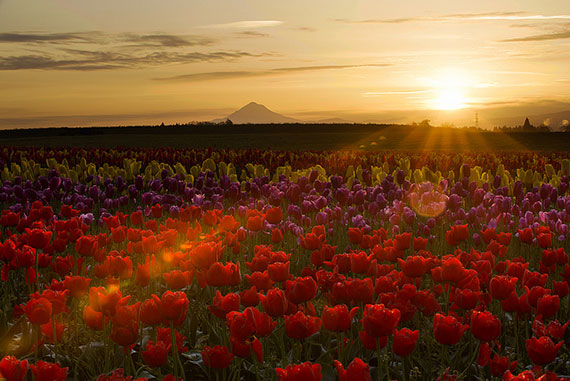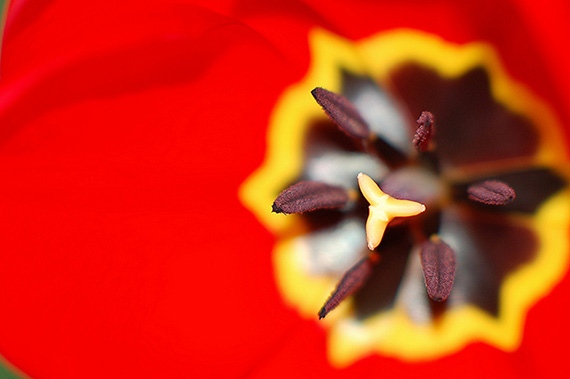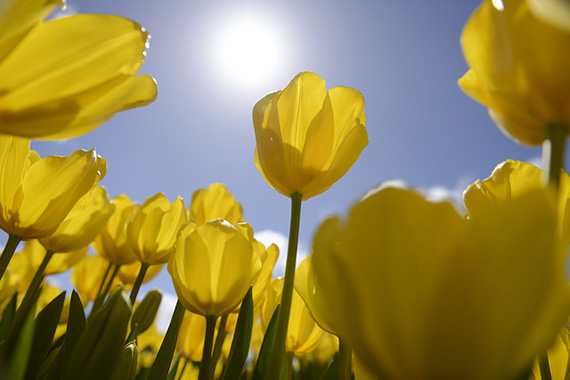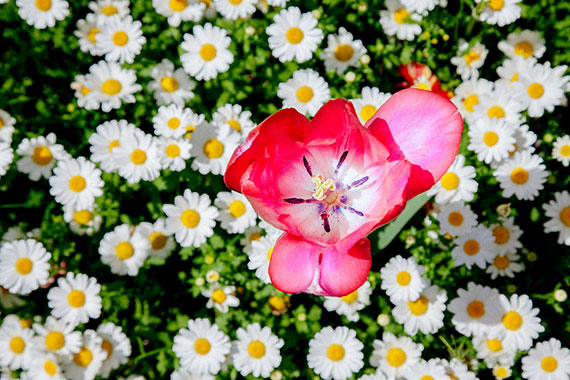Tulips are only in bloom a few weeks out of the year, so if you love photographing them as much as I do, you have to hit the tulip beds running—or at least with a plan.

photo by Bill Young
Like roses, no two tulips are alike. But the fun part is, unlike roses, every type of tulip is different. From their size, to their shape, to their texture, you could easily be taking a photo of a beautiful petite little flower, without realizing that it’s actually a type of tulip.
I love taking pictures of tulips, because I love the challenge of capturing the reason that a particular flower grabbed my attention.
Was it the color that drew me over? A whole bed of multicolored beauties waving in the wind? Maybe it’s a unique type of tulip I’ve never seen before. Or it could be the texture. Some varieties like parrot tulips have veins and patterns that look more like a cabbages than flowers and are just begging to be captured.
Then there are the personalities of the flowers—one tulip standing head and shoulders above the rest. A yellow tulip in a bed of purple, or a gathering of one kind of flowers centered directly inside another.

photo by Yuri Levchenko
Taking a moment to figure out what intrigues me about the flower helps me capture its beauty. Once you find a gorgeous bunch of blooms, don’t just start clicking away. Taking a few moments to examine them helps you find the story in the petals.
In fact, I never look through the viewfinder without thinking about the story I want to tell.
First I decide which tulip will be the star of my story. Do I want to capture the pink tulip bending its head down over the one standing beside it? I move around a bit to frame my story. One inch to the left, including a lush green bush, makes the flower look like it’s in a forest. It’s a totally different story if I move an inch to the right, revealing nothing but soil or an interesting fence or part of a sidewalk.
Then I consider the light. Red, yellow and orange tulips love the light. Try to get full sun behind them and they’ll take on an ethereal glow that makes them look more like lollipops than flowers. The darker colors like deep purple or black are very difficult to capture.

photo by Chris Phutully
If you can move to a place where the sun is in front of the flower and illuminates it, that will help separate the flower from its background. Or another trick is to photograph darker blooms early in the day when they’re still covered in dew. That gives them a 3D effect that also helps define the edges of the flower and its stem.
Another tip is to put your camera on the macro/flower setting if you have one, to help you capture photos up close. There’s no need to use a flash under most lighting conditions. And then, simply click away until the shots you get are the same ones that captured your heart.
Which leads me to my most important tip. When in doubt, take the picture! Don’t decide not to photograph a tulip because it’s completely open or beginning to droop. Half of the charm of photographing tulips are the “faces” that start to appear inside the flowers once they open. Try photographing an open tulip from every angle and I guarantee when you upload the photos to your computer you’ll be amazed at the beauty you’ve captured.

photo by Sonny Abesamis
And never, ever wait until tomorrow to take a photo that you want to take. Tulips don’t last long and more than once we’ve gone back, even a few hours later, to find the flower bent over—or worse, completely gone. Take the photo now, even if the conditions are not ideal, and then come back again if you can, to get an even better shot. If you can that’s great—you’ll have two prize-winning shots. But if you can’t, you’ll still have at least one version of the photo you wanted.
Photographing tulips takes a little practice and a lot of patience. But after a few times out in the field, we’re sure you’ll agree that the results you’ll achieve are absolutely worth it.
About the Author:
Author and photographer Laura Greenwald spent the last few tulip seasons in a tiny Chicago neighborhood called Streeterville, just off the Magnificent Mile. Her journey of Chicago’s most incredible blooms is called “The Wealth Of Tulips”. Check out her photos and books at http://www.wix.com/janlor/wealthoftulips and on Pinterest at http://www.pinterest.com/wealthoftulips.
For Further Training on Flower Photography:
The 2nd edition of this in-depth flower photography guide has been completely revamped with new sections and updated content on every aspect of photographing flowers for photographers of all experience levels.
Learn more: The Wildflower Photography Guide
Go to full article: Tulip Season Photography Tips
What are your thoughts on this article? Join the discussion on Facebook
Article from: PictureCorrect